So, there we were in the 2015 Kia Soul EV, zipping silently through traffic on our way to Kohl?s department store. We live in the northeast part of the Portland (Oregon) Urban Metro area and even though there are several Kohl?s stores closer, we decided to push our comfort level and drive to the store located in Clackamas, 26 miles south.
We?ve driven most of the available electric cars the last few years and know that the range can vary considerably based on the driving conditions and terrain. We assumed the Soul EV should easily make it back up the hill to our house, because the range gauge indicated 85 miles when we started. Another safety factor was that Kohl?s is one of the area businesses that has free electric car chargers for their customers.
 The Soul EV range gauge indicated 61 miles ? not bad, we drove 26 miles at freeway speeds and clicked off only 23 miles on the gauge. This was our first solo venture to a public charger where we were not coached by a manufacturer representative. The Kohl?s store has two chargers — one was plugged into an electric Ford Focus with someone behind the wheel, the other was open, so Bill parked in front of the open charger, determined to take advantage of a free charge
The Soul EV range gauge indicated 61 miles ? not bad, we drove 26 miles at freeway speeds and clicked off only 23 miles on the gauge. This was our first solo venture to a public charger where we were not coached by a manufacturer representative. The Kohl?s store has two chargers — one was plugged into an electric Ford Focus with someone behind the wheel, the other was open, so Bill parked in front of the open charger, determined to take advantage of a free charge
The guy in the Ford jumped out when we pulled up and started toward the Kia Soul EV smiling and pointing saying, ?that?s my next car.?
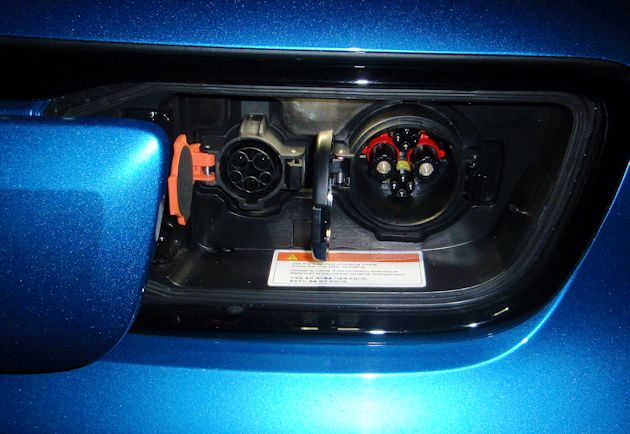 We popped the release for the charger port, which is behind a solid panel in the grille area of the Kia. Bill unwound the charging cable and plugged it into the smaller of the two standard charging ports, a SAE J1772 port for 120- and 240-volt AC charging. The larger port is for 440-volt fast-charging. It can charge the battery to 80 percent in as little as 33 minutes with a 50 Kw?output fast charger (five hours using a 240-volt outlet).
We popped the release for the charger port, which is behind a solid panel in the grille area of the Kia. Bill unwound the charging cable and plugged it into the smaller of the two standard charging ports, a SAE J1772 port for 120- and 240-volt AC charging. The larger port is for 440-volt fast-charging. It can charge the battery to 80 percent in as little as 33 minutes with a 50 Kw?output fast charger (five hours using a 240-volt outlet).
 Bill went to the charger screen to figure out what buttons to push to make the charging start?then the whole process came to a quick halt. The charge is free, but you needed to have a card or a smart phone app with the Blink Network. That was news to us.
Bill went to the charger screen to figure out what buttons to push to make the charging start?then the whole process came to a quick halt. The charge is free, but you needed to have a card or a smart phone app with the Blink Network. That was news to us.
Fortunately, Kevin, our new electric car friend from the Ford Focus, explained what we needed and offered to use his card to start our charging process. An avid electric car fan, Kevin told us how to register for our own card.
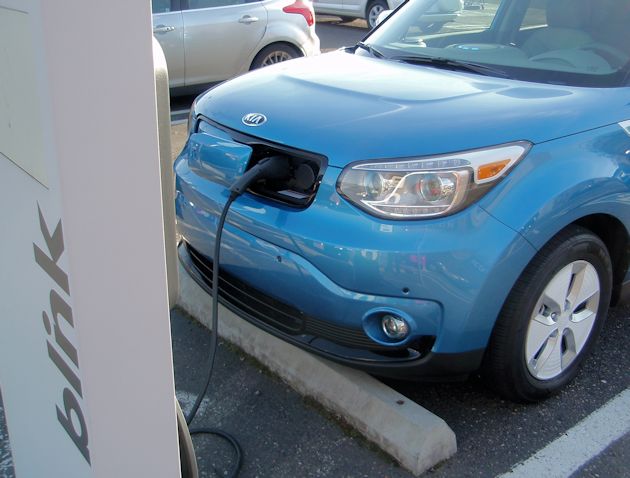 While Barbara shopped Bill got on his smartphone and registered with Blink and downloaded their app using the Kohl?s free Wi-Fi. After about 45 minutes of shopping we came out and Kevin was waiting. He was charged, but wanted to talk electric cars and ask questions about the Kia Soul EV. Kevin also told us about other places to get a fast charge and find other charging opportunities in our area.
While Barbara shopped Bill got on his smartphone and registered with Blink and downloaded their app using the Kohl?s free Wi-Fi. After about 45 minutes of shopping we came out and Kevin was waiting. He was charged, but wanted to talk electric cars and ask questions about the Kia Soul EV. Kevin also told us about other places to get a fast charge and find other charging opportunities in our area.
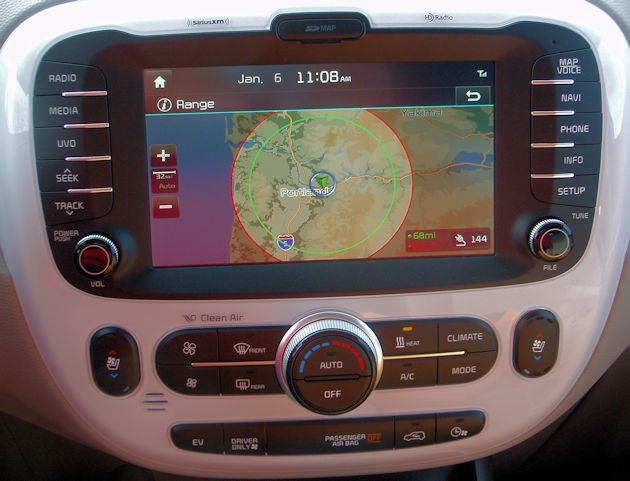 With our battery charged to a range of 74 miles, thanks to Kohl?s, we took the long way home and arrived with power to spare. We know Portland is a hotbed of electric car activity, so we checked the area with our new Blink access and were surprised to find there were more than 200 chargers in the Portland area. Going to the active map we could even determine which ones were available for charging right now and the prices of those charging for charging.
With our battery charged to a range of 74 miles, thanks to Kohl?s, we took the long way home and arrived with power to spare. We know Portland is a hotbed of electric car activity, so we checked the area with our new Blink access and were surprised to find there were more than 200 chargers in the Portland area. Going to the active map we could even determine which ones were available for charging right now and the prices of those charging for charging.
The standard navigation system in the Soul EV also shows you how far you can go on the current charge level and will give you a list of nearby charge stations, should your range anxiety and range gauge collide, and you feel the need to charge.
 When we arrived home we pulled the 120-volt charge cable from its compartment under the cargo floor, opened the front charge port and plugged it in using a regular garage outlet. By the next morning we had another full charge.
When we arrived home we pulled the 120-volt charge cable from its compartment under the cargo floor, opened the front charge port and plugged it in using a regular garage outlet. By the next morning we had another full charge.
 The Soul EV is Kia?s first venture into pure electric vehicles, and they picked one of their most popular models to represent the brand?s efforts in the all-electric-zero emissions arena. The hip urban crossover is well designed to handle the transition with the 109-hp electric motor fitting nicely under the hood in place of the gasoline engine. The motor produces 210-lb.ft. of torque giving it spunky response when stepping on the accelerator. Under full acceleration, the Soul hums up to 60 mph in 9.2 seconds according to a buff magazine. The motor is liquid cooled and uses multi-layer magnets which improve efficiency and reduce the familiar electric motor whine. The Soul EV has a top speed electronically limited to 90 mph.
The Soul EV is Kia?s first venture into pure electric vehicles, and they picked one of their most popular models to represent the brand?s efforts in the all-electric-zero emissions arena. The hip urban crossover is well designed to handle the transition with the 109-hp electric motor fitting nicely under the hood in place of the gasoline engine. The motor produces 210-lb.ft. of torque giving it spunky response when stepping on the accelerator. Under full acceleration, the Soul hums up to 60 mph in 9.2 seconds according to a buff magazine. The motor is liquid cooled and uses multi-layer magnets which improve efficiency and reduce the familiar electric motor whine. The Soul EV has a top speed electronically limited to 90 mph.
 The battery tucks nicely under the rear seat area and the flat design minimizes intrusion into the cabin reducing rear leg room by about three inches, but it still has more legroom than some competitors. Rear cargo space remains unchanged at a spacious 18.8 cubic feet, so it shouldn?t limit shopping purchases.
The battery tucks nicely under the rear seat area and the flat design minimizes intrusion into the cabin reducing rear leg room by about three inches, but it still has more legroom than some competitors. Rear cargo space remains unchanged at a spacious 18.8 cubic feet, so it shouldn?t limit shopping purchases.
 The 27kWh lithium battery is larger than the competitor batteries which range from 20 to 24kWh. That means better range. The extra battery power gives this new Soul EV an estimated 93 mile range and earns it an EPA MPGe (miles per gallon equivalent) rating of 92 miles highway and 120 miles city and a combined rating of 105 miles.
The 27kWh lithium battery is larger than the competitor batteries which range from 20 to 24kWh. That means better range. The extra battery power gives this new Soul EV an estimated 93 mile range and earns it an EPA MPGe (miles per gallon equivalent) rating of 92 miles highway and 120 miles city and a combined rating of 105 miles.
 In addition to charging when it?s plugged in the Soul EV also uses Kia?s third-generation regenerative braking system which can capture up to 12 percent of the car?s kinetic energy, which is fed back into the battery while the Soul EV is coasting and braking.?The car has four drive mode combinations to allow the driver to program the car for the type of driving, and that can affect the battery usage.
In addition to charging when it?s plugged in the Soul EV also uses Kia?s third-generation regenerative braking system which can capture up to 12 percent of the car?s kinetic energy, which is fed back into the battery while the Soul EV is coasting and braking.?The car has four drive mode combinations to allow the driver to program the car for the type of driving, and that can affect the battery usage.
Before starting out on our first drive in the Soul EV, we had just returned from a road trip in our previous test car and still had several chapters to finish our audio book. We were shocked to discover that the Kia Soul EV did not have the available CD player, so we had to finish our book in our next test car.
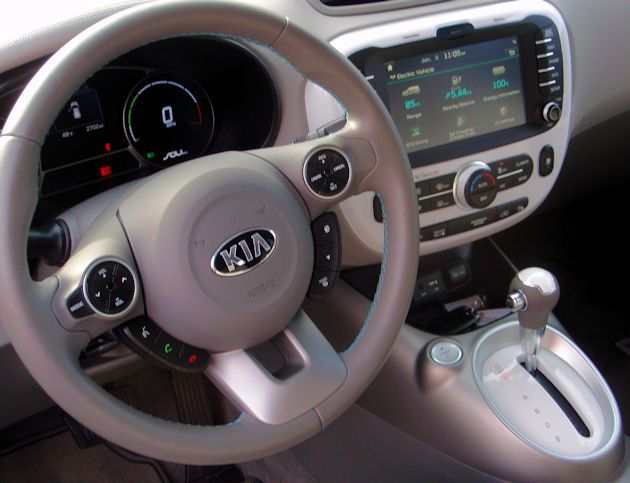 The Kia specs show a CD, but we couldn?t find it. It did have an AM/FM radio, HD Radio, Sirius XM radio and the UVO eService along with USB and audio input jacks. Kia?s innovative UVO EV Services is included free for the first five years. The special version of this telematics and infotainment system is expanded to help the EV better manage charging and find available charge stations using a smart phone app.
The Kia specs show a CD, but we couldn?t find it. It did have an AM/FM radio, HD Radio, Sirius XM radio and the UVO eService along with USB and audio input jacks. Kia?s innovative UVO EV Services is included free for the first five years. The special version of this telematics and infotainment system is expanded to help the EV better manage charging and find available charge stations using a smart phone app.
Soul EV pricing starts at $33,700 plus the destination charge, however when you factor in the $7,500 federal tax credit, the price looks reasonable at $26,200. There is one other trim level which adds $2,000 to price and features like leather seating, parking assist, fog lights, heated and ventilated front seats and power folding outside mirrors. One feature we?d like to see is a blind spot warning system, because the large ?C? pillar makes it difficult to see other vehicles in your blind spot.
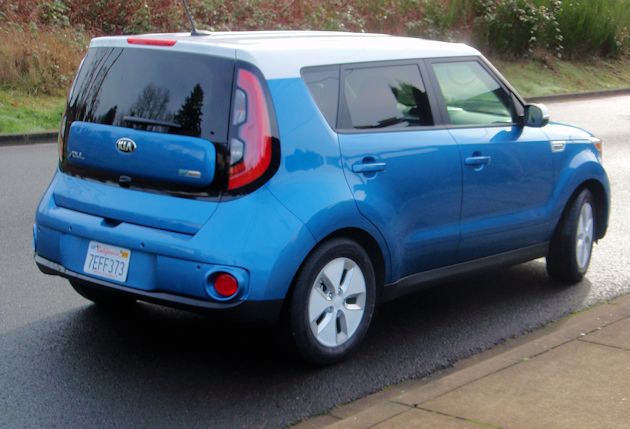 Driving the Soul EV is not much different from driving the popular gasoline-powered model. Obviously it?s quieter and smoother, but it accelerated comfortably and even passes quickly when necessary. Unless you are pulling up to a charger, or someone is ?into? electric cars most people won?t notice much difference. Visually, the aerodynamic-looking wheels, the solid grille area and the logo on the back are the only external differences.
Driving the Soul EV is not much different from driving the popular gasoline-powered model. Obviously it?s quieter and smoother, but it accelerated comfortably and even passes quickly when necessary. Unless you are pulling up to a charger, or someone is ?into? electric cars most people won?t notice much difference. Visually, the aerodynamic-looking wheels, the solid grille area and the logo on the back are the only external differences.
The Kia Soul EV makes a lot of sense for someone or a family that sticks fairly close to home or uses it for a commute. Owners can save big by not having to buy gasoline and that provides a nice benefit for the environment. A good scenario would be to have a Kia Soul EV for around town and something like a Kia Optima for trips out of town ? or you could rent a car for the out of town trips.









